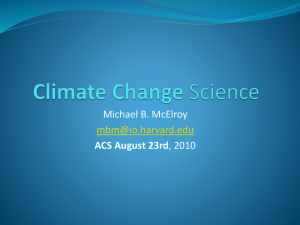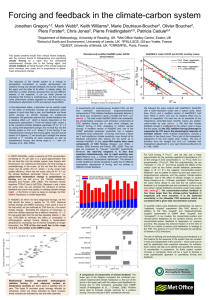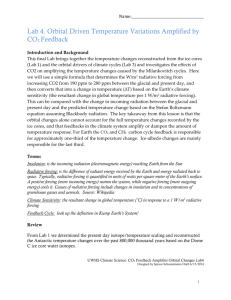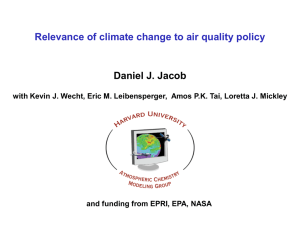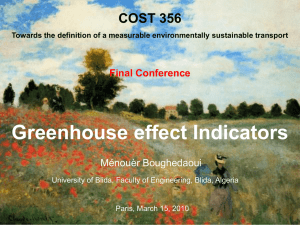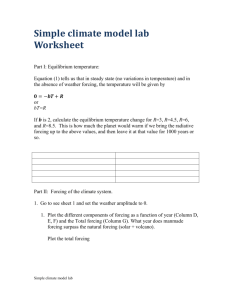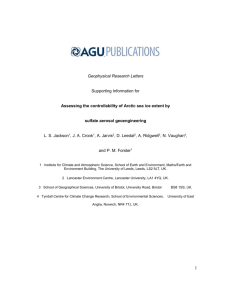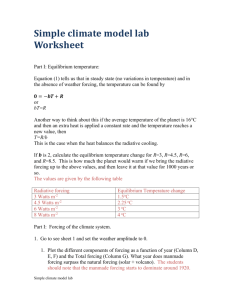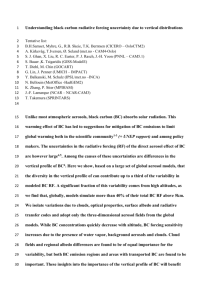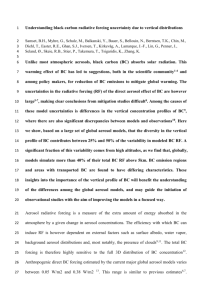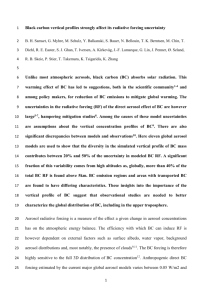Supplementary Information
advertisement
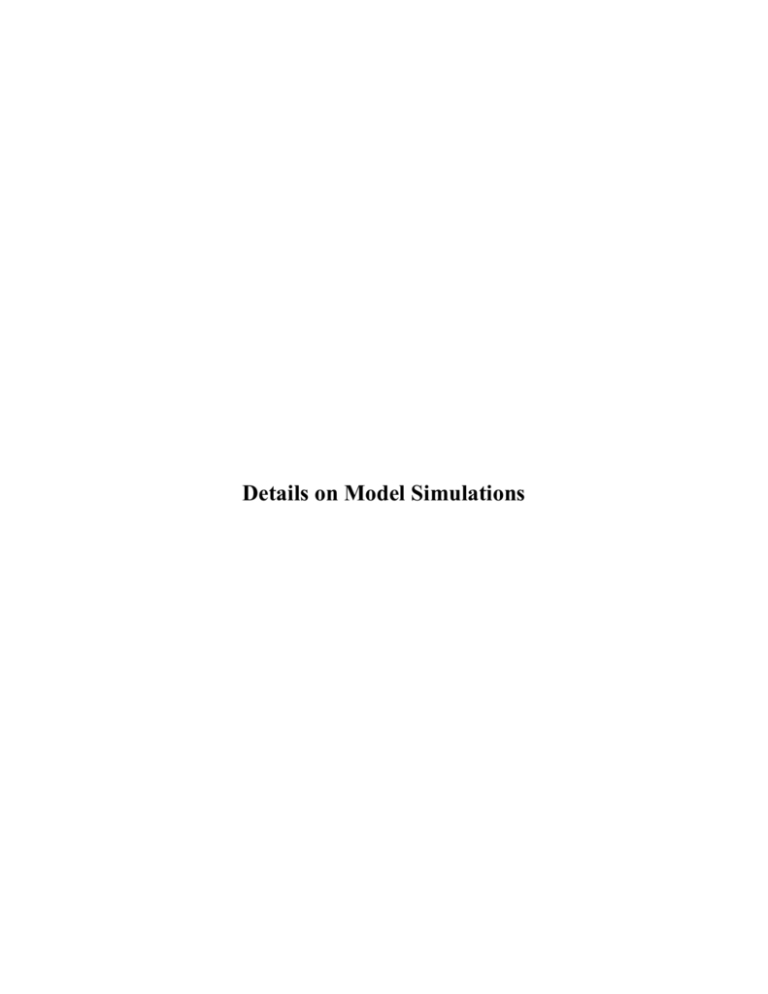
Details on Model Simulations Energy Balance Model Description: We employed a simple zero-dimensional Energy Balance Model (“EBM”--see e.g. refs 15) of the form C dT/dt = S(1-)/4 + FGHG -A-B T + w(t) to model the forced response of the climate to estimate natural and anthropogenic radiative forcing. T is the temperature of Earth’s surface (approximated as the surface of a 70 m depth mixed layer ocean covering 70% of Earth’s surface area). C=2.08 x 108 J K-1m-2 is an effective heat capacity that accounts for the thermal inertia of the mixed layer ocean, but does not allow for heat exchange with the deep ocean as in more elaborate “upwellingdiffusion models” (ref. 6), S ≈1370 Wm-2 is the solar constant, and ≈0.3 is the effective surface albedo. FGHG is the radiative forcing by greenhouse gases. w(t) represents random weather effects, and was set to zero to analyze the pure radiatively forced response. The linear “gray body” approximation (ref. 3) LW=A+B T was used to model outgoing longwave radiation in a way that accounts for the greenhouse effect. The choice A=221.3 WK-1m-2 and B=1.25 Wm-2 yields a realistic pre-industrial global mean temperature T=14.8 oC and an equilibrium climate sensitivity (ECS) of T2xCO2=3.0oC, consistent with mid-range IPCC estimates (ref. 7). B can be varied to change the ECS of the EBM. For example, the higher value B=1.5 Wm-2 yields a more conservative (ECS) of T2xCO2=2.5oC. Energy Balance Model Simulations: Historical Simulations: The model was driven with estimated annual natural and anthropogenic forcing over AD AD 850-2012. Greenhouse radiative forcing was calculated using the approximation (ref. 8) FGHG=5.35log(CO2e/280), where 280 ppm is the preindustrial CO2 level and CO2e is the “equivalent” anthropogenic CO2,. We used the CO2 data from ref. 9, scaled to give CO2e values 20% larger than CO2 alone (e.g. in 2009, CO2 was 380 ppm while CO2e was estimated at 455 ppm). Northern Hemisphere anthropogenic tropospheric aerosol forcing was not available for ref. 9 so was taken instead from ref. 2, with an increase in amplitude by 5% to accommodate a slightly larger indirect effect than in ref 2, and a linear extrapolation of the original series (which ends in 1999) to extend though 2012. Estimated past changes in solar irradiance were prescribed as a change in the solar constant S, while forcing by volcanic aerosols was prescribed as a change in the surface albedo . Solar and volcanic forcing were taken from the GCM simulation of ref 3 described in the section above, with the following modifications: (1) solar forcing was rescaled under the assumption of a 0.1% change from Maunder Minimum to present more consistent with recent estimates (ref. 9); (2) volcanic forcing was applied as the mean of the latitudinally-varying volcanic forcing of ref. 9, (3) values for both series were updated through 2012. Future Projections: For the purpose of the “business as usual” future projections, we have linearly extrapolated the CO2 radiative forcing forward to 2100 based on the trend over the past decade (which is roughly equivalent from a radiative forcing standpoint to a forward projection of the exponential historical, trajectory of CO2 emissions). We assume constant solar output, and assume no climatically significant future volcanic eruptions. We have assumed that tropospheric aerosols decrease exponentially from their current values with a time constant of 60 years. This gives a net anthropogenic forcing change from 2000 to 2100 of 3.5 Wm-2, roughly equivalent to the IPCC 5th assessment report “RCP6” scenario, a future emissions scenario that assumes only modest efforts at mitigation. Stabilization Scenarios: For the stabilization scenarios, we relax (with a 20 year time constant) the CO2 concentration to a maximum specified value at 2100. We considered cases both where the anthropogenic tropospheric aerosol burden is assumed to (a) decrease exponentially from their current values with a time constant of 60 years, as in the future projections discussed in the previous section and alternatively (b) remain constant at its current value. Additional Details Sensitivity analyses of the historical simulations were performed by Mann et al 2012 (ref 4) with respect to (i) the equilibrium climate sensitivity assumed (varied from T2xCO2=2-4 oC), the (ii) solar scaling (0.25% in place of 0.1% Maunder Minimumpresent change), (iii) the volcanic aerosol loading estimates used, and (iv) the scaling of volcanic radiative forcing with respect to aerosol loading to account for possible size distribution effects. All of the alternative choices described above were found to yield qualitatively similar results. Matlab © source code for the energy balance model, data used in the calculations, and the simulation results discussed in the main articl are available at: www.meteo.psu.edu/holocene/public_html/supplements/EBMProjections References 1. North, G. R., Cahalan, R.F. & Coakley, J.A. Energy balance climate models, Rev. Geophys. 19, 91–121 (1981). 2. Crowley, T.J. Causes of climate change over the past 1000 years. Science 289, 270– 277 (2000). 3. McGuffie, K. & Henderson-Sellers, A. A Climate Modeling Primer, 2nd Edition, Wiley, (1997). 4. Mann, M.E., Fuentes, J.D., Rutherford, S., Underestimation of Volcanic Cooling in Tree-Ring Based Reconstructions of Hemispheric Temperatures, Nature Geoscience, 5, 202–205 (2012). 5. Mann, M.E., Rutherford, S., Schurer, A., Tett, S.F.B., Fuentes, J.D., Discrepancies Between the Modeled and Proxy-Reconstructed Response to Volcanic Forcing over the Past Millennium: Implications and Possible Mechanisms, J. Geophys. Res. 118, 76177627, doi:10.1002/jgrd.50609 (2013). 6. Wigley, T. M. L. & Raper, S. C. B. Natural variability of the climate system and detection of the greenhouse effect. Nature 344, 324– 327 (1990). 7. IPCC, 2007: Climate Change 2007: The Physical Science Basis. Contribution of Working Group I to the Fourth Assessment Report of the Intergovernmental Panel on Climate Change [Solomon, S., D. Qin, M. Manning, Z. Chen, M. Marquis, K.B. Averyt, M.Tignor and H.L. Miller (eds.)]. Cambridge University Press, Cambridge, United Kingdom and New York, NY, USA. 8. Myhre, G., Highwood, E.J., Shine, K.P. & Stordal, F. New estimates of radiative forcing due to well mixed greenhouse gases, Geophys. Res. Lett. 25, 2715-2718, 1998. 9. Ammann, C. M. et. al. Solar influence on climate during the past millennium: Results from transient simulations with the NCAR Climate System Model. Proc. Natl. Acad. Sci. 104, 3713–3718 (2007).

